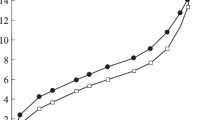Abstract
Modern concepts about the structural organization of cellulose and the character of formation of its inter- and intermolecular hydrogen bonds are analyzed. A scheme for the structure of the cellulose microfibril that supposes the presence of slit-shaped micropores in its structure is proposed. The proton magnetic relaxation study of sorption processes reveals that, at a moisture content of 7–10%, the filling of cellulose micropores occurs with a concomitant increase in their lateral sizes and decreases in the degrees of crystallinity of samples.
Similar content being viewed by others
References
D. P. Delmer and Y. Amor, Plant Cell 7, 987 (1995).
N. C. Carpita, Plant Physiol. 155(1), 171 (2011).
Yu. B. Grunin, L. Yu. Grunin, E. A. Nikolskaya, and V. I. Talantsev, Polym. Sci., Ser. A 54(3), 201 (2012).
Z. A. Rogovin, Cellulose Chemistry (Khimiya, Moscow, 1972).
D. L. VanderHart and R. H. Atalla, Macromolecules 17, 1465 (1984).
Y. Nishiyama, P. Langan, and H. Chanzy, J. Am. Chem. Soc. 124, 9074 (2002).
Y. Nishiyama, J. Sugiyama, H. Chanzy, and P. Langan, J. Am. Chem. Soc. 125, 14300 (2003).
H. Chanzy, Cellulose Sources and Exploitation. Industrial Utilisation, Biotechnology and Physic Chemical Properties (Ellis Horwood, New York, 1990).
K. Mazeau, Carbohydr. Polym. 84(4), 524 (2011).
Y. Nishiyama, G. P. Johnson, A. D. French, V. T. Forsyth, and P. Langan, Biomacromolecules 9(11), 3133 (2008).
J. Wohlert, M. Bergenstrahle-Wohlert, and L. A. Berglund, Cellulose 19, 1821 (2012).
Y. Nishiyama, J. Wood Sci. 55, 241 (2009).
N. I. Nikitin, Chemistry of Wood and Cellulose (Inst. Macromol. Comp. AN USSR, Leningrad, 1962) [in Russian].
Q. Li and S. Renneckar, Biomacromolecules 12(3), 650 (2011).
M. Ibrahim and H. Mondal, Cellulose 20, 1073 (2013).
Yu. B. Grunin, L. Yu. Grunin, E. A. Nikol’skaya, V. I. Talantsev, and G. Sh. Gogelashvili, Russ. J. Phys. Chem. A 87(1), 100 (2013).
H. R. Tang and P. S. Bellton, Solid State Nucl. Magn. Reson. 21, 117 (2002).
V. P. Nikolaev, A. A. Ageev, and Yu. G. Frolov, Tr. Moskovskogo Khim.-Tekhn. In-ta im. D.I. Mendeleeva, No. 101, 84 (1978).
Resonance Systems Ltd. http://www.nmr-design.com.
V. I. Chizhik, Nuclear Magnetic Relaxation (St. Petersburg State Univ., St. Petersburg, 2004) [in Russian].
A. Abragam, Principles of Nuclear Magnetism (Clarendon Press, Oxford, 1961; Nauka, Moscow, 1963).
V. V. Mank and N. I. Lebovka, NMR Spectroscopy of water in Heterogeneous Systems (Naukova dumka, Kiev, 1988) [in Russian].
Yu. B. Grunin, Doctoral Dissertation in Chemistry (IKhD AN, Riga, 1989).
N. Bikales and L. Segal, Cellulose and Cellulose Derivatives (Wiley-Interscience, New York, 1971; Mir, Moscow, 1974), Vols. IV–V.
T. P. Shcherbakova, N. E. Kotel’nikova, and Yu. V. Bykhovtseva, Russ. J. Bioorg. Chem. 38(7), 689 (2012).
M. M. Dubinin, Zh. Phiz. Khim., No. 5, 1301 (1987).
R. J. Maurer, A. F. Sax, and V. Ribitsch, Cellulose 20, 25 (2013).
H. Ono, H. Yamada, S. Matsuda, K. Okajima, T. Kawamoto, and H. Iijima, Cellulose 5, 231 (1998).
S. J. Gregg and K. S. Sing, Adsorption, Surface Area and Porosity, 2nd ed. (Academic Press, Inc., London, 1982; Mir, Moscow, 1984).
T. Yamashiki, T. Matsui, M. Saitoh, Y. Matsuda, K. Okajima, K. Kamide, and T. Sawada, Br. Polym. J. 22(3), 201 (1990).
Author information
Authors and Affiliations
Corresponding author
Additional information
Original Russian Text © L.Yu. Grunin, Yu.B. Grunin, V.I. Talantsev, E.A. Nikolskaya, D.S. Masas, 2015, published in Vysokomolekulyarnye Soedineniya. Ser. A, 2015, Vol. 57, No. 1, pp. 46–55.
Rights and permissions
About this article
Cite this article
Grunin, L.Y., Grunin, Y.B., Talantsev, V.I. et al. Features of the structural organization and sorption properties of cellulose. Polym. Sci. Ser. A 57, 43–51 (2015). https://doi.org/10.1134/S0965545X15010034
Received:
Revised:
Published:
Issue Date:
DOI: https://doi.org/10.1134/S0965545X15010034




